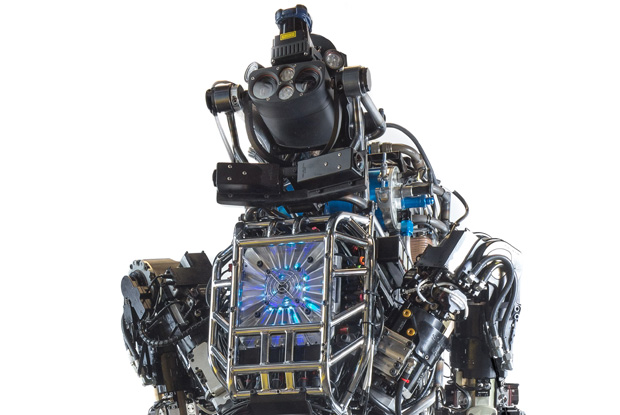 It’s no secret that the progress being made in terms of robotics, autonomous systems, and artificial intelligence is making many people nervous. With so many science fiction franchises based on the of intelligent robots going crazy and running amok, its understandable that the US Department of Defense would seek to get in front of this issue before it becomes a problem. Yes, the US DoD is hoping to preemptively avoid a Skynet situation before Judgement Day occurs. How nice.
It’s no secret that the progress being made in terms of robotics, autonomous systems, and artificial intelligence is making many people nervous. With so many science fiction franchises based on the of intelligent robots going crazy and running amok, its understandable that the US Department of Defense would seek to get in front of this issue before it becomes a problem. Yes, the US DoD is hoping to preemptively avoid a Skynet situation before Judgement Day occurs. How nice.
Working with top computer scientists, philosophers, and roboticists from a number of US universities, the DoD recently began a project that will tackle the tricky topic of moral and ethical robots. Towards this end, this multidisciplinary project will first try to pin down exactly what human morality is, and then try to devise computer algorithms that will imbue autonomous robots with moral competence — basically, the ability to recognize right from wrong and choose the former.
 This project is being carried out by researchers from Tufts, Brown, and the Rensselaer Polytechnic Institute (RPI), with funding from the Office of Naval Research (ONR). ONR, like DARPA, is a wing of the Department of Defense that mainly deals with military research and development. The first task, as already mentioned, will be to use theoretical (philosophical) and empirical (experimental) research to try to isolate essential elements of human morality.
This project is being carried out by researchers from Tufts, Brown, and the Rensselaer Polytechnic Institute (RPI), with funding from the Office of Naval Research (ONR). ONR, like DARPA, is a wing of the Department of Defense that mainly deals with military research and development. The first task, as already mentioned, will be to use theoretical (philosophical) and empirical (experimental) research to try to isolate essential elements of human morality.
These findings will then be extrapolated into a formal moral framework, which in turn can be implemented in software – most likely some kind of deep neural network. Assuming they can isolate some kind or “moral imperative”, the researchers will then take an advanced robot — something like Atlas or BigDog — and imbue its software with a algorithm that captures this. Whenever an ethical situation arises, the robot would then turn to this programming to decide what avenue was the best coarse of action.
 One of the researchers involved in the project, Selmer Bringsjord at RPI, envisions these robots using a two-stage approach for picking right from wrong. First the AI would perform a “lightning-quick ethical check” — like “should I stop and help this wounded soldier?” Depending on the situation, the robot would then decide if deeper moral reasoning is required — for example, if the robot should help the wounded soldier or carry on with its primary mission of delivering vital ammo and supplies to the front line where other soldiers are at risk?
One of the researchers involved in the project, Selmer Bringsjord at RPI, envisions these robots using a two-stage approach for picking right from wrong. First the AI would perform a “lightning-quick ethical check” — like “should I stop and help this wounded soldier?” Depending on the situation, the robot would then decide if deeper moral reasoning is required — for example, if the robot should help the wounded soldier or carry on with its primary mission of delivering vital ammo and supplies to the front line where other soldiers are at risk?
Eventually, this moralistic AI framework will also have to deal with tricky topics like lethal force. For example, is it okay to open fire on an enemy position? What if the enemy is a child soldier? Should an autonomous UAV blow up a bunch of terrorists? What if it’s only 90% sure that they’re terrorists, with a 10% chance that they’re just innocent villagers? What would a human UAV pilot do in such a case — and will robots only have to match the moral and ethical competence of humans or be held to a higher standard?
 While we’re not yet at the point where military robots have to decide which injured soldier to carry off the battlefield, or where UAVs can launch Hellfire missiles at terrorists without human intervention, it’s very easy to imagine a future where autonomous robots are given responsibility for making those kinds of moral and ethical decisions in real time. In short, the decision by the DoD to begin investigating a morality algorithm demonstrates foresight and sensible planning.
While we’re not yet at the point where military robots have to decide which injured soldier to carry off the battlefield, or where UAVs can launch Hellfire missiles at terrorists without human intervention, it’s very easy to imagine a future where autonomous robots are given responsibility for making those kinds of moral and ethical decisions in real time. In short, the decision by the DoD to begin investigating a morality algorithm demonstrates foresight and sensible planning.
In that respect, it is not unlike the recent meeting that took place at the United Nations European Headquarters in Geneva, where officials and diplomats sought to address placing legal restrictions on autonomous weapons systems, before they evolve to the point where they can kill without human oversight. In addition, it is quite similar to the Campaign to Stop Killer Robots, an organization which is seeking to preemptively ban the use of automated machines that are capable of using lethal force to achieve military objectives.
 In short, it is clearly time that we looked at the feasibility of infusing robots (or more accurately artificial intelligence) with circuits and subroutines that can analyze a situation and pick the right thing to do — just like a human being. Of course, this raises further ethical issues, like how human beings frequently make choices others would consider to be wrong, or are forced to justify actions they might otherwise find objectionable. If human morality is the basis for machine morality, paradoxes and dilemmas are likely to emerge.
In short, it is clearly time that we looked at the feasibility of infusing robots (or more accurately artificial intelligence) with circuits and subroutines that can analyze a situation and pick the right thing to do — just like a human being. Of course, this raises further ethical issues, like how human beings frequently make choices others would consider to be wrong, or are forced to justify actions they might otherwise find objectionable. If human morality is the basis for machine morality, paradoxes and dilemmas are likely to emerge.
But at this point, it seems all but certain that the US DoD will eventually break Asimov’s Three Laws of Robotics — the first of which is “A robot may not injure a human being or, through inaction, allow a human being to come to harm.” This isn’t necessarily a bad thing, but it will open Pandora’s box. On the one hand, it’s probably a good idea to replace human soldiers with robots. But on the other, if the US can field an entirely robotic army, war as a tool of statecraft suddenly becomes much more acceptable.
 As we move steadily towards a military force that is populated by autonomous robots, the question of controlling them, and whether or not we are even capable of giving them the tools to choose between right and wrong, will become increasingly relevant. And above all, the question of whether or not moral and ethical robots can allow for some immoral and unethical behavior will also come up. Who’s to say they won’t resent how they are being used and ultimately choose to stop fighting; or worse, turn on their handlers?
As we move steadily towards a military force that is populated by autonomous robots, the question of controlling them, and whether or not we are even capable of giving them the tools to choose between right and wrong, will become increasingly relevant. And above all, the question of whether or not moral and ethical robots can allow for some immoral and unethical behavior will also come up. Who’s to say they won’t resent how they are being used and ultimately choose to stop fighting; or worse, turn on their handlers?
My apologies, but any talk of killer robots has to involve that scenario at some point. It’s like tradition! In the meantime, be sure to stay informed on the issue, as public awareness is about the best (and sometimes only) safeguard we have against military technology being developed without transparency, not to mention running amok!
Source: extremetech.com
 Rumors have been flying for over a year now as to what the new Terminator relaunch will look like, and what the plot will entail. We knew in advance that Anrie would be back (sorry!), that the movie would be set in the future and the present, and that it would be rebooting the plot after the last few abortive sequels. Well, they finally released a full-length trailer that answers all the nagging questions, it seems!
Rumors have been flying for over a year now as to what the new Terminator relaunch will look like, and what the plot will entail. We knew in advance that Anrie would be back (sorry!), that the movie would be set in the future and the present, and that it would be rebooting the plot after the last few abortive sequels. Well, they finally released a full-length trailer that answers all the nagging questions, it seems! And of course, there’s a ton of shooting and shit getting blown up! We also get to see from this trailer who will be playing whom, and the cast looks pretty good. Arnie reprises the role of the good Terminator (interesting that he’s aged), Emilia Clarke (of GOT fame) plays Sarah Conner, Jason Clarke is John Conner, Jai Courtney (Sam Worthington’s less-talented clone) is Kyle Reese, and Byung hun Lee (of G.I. Joe fame) is the evil T-1000.
And of course, there’s a ton of shooting and shit getting blown up! We also get to see from this trailer who will be playing whom, and the cast looks pretty good. Arnie reprises the role of the good Terminator (interesting that he’s aged), Emilia Clarke (of GOT fame) plays Sarah Conner, Jason Clarke is John Conner, Jai Courtney (Sam Worthington’s less-talented clone) is Kyle Reese, and Byung hun Lee (of G.I. Joe fame) is the evil T-1000.
 This tool, which was created in 1994, instructs search engines and other automated bots to avoid crawling certain pages or directories of a website. The industry has done a remarkable job staying true to the simple text file in the two decades since; Google, Bing, and Yahoo still obey its directives. The changes they uploaded read like this, just in case you’re planning on adding your name to the “disallow” list:
This tool, which was created in 1994, instructs search engines and other automated bots to avoid crawling certain pages or directories of a website. The industry has done a remarkable job staying true to the simple text file in the two decades since; Google, Bing, and Yahoo still obey its directives. The changes they uploaded read like this, just in case you’re planning on adding your name to the “disallow” list:
 Basically, as Google’s senior VP of technical infrastructure Urs Hölze spoke about their cloud platform, the unidentified man stood up and began screaming “You all work for a totalitarian company that builds machines that kill people!” As you can see from the video below, Hölze did his best to take the interruptions in stride and continued with the presentation. The protestor was later escorted out by security.
Basically, as Google’s senior VP of technical infrastructure Urs Hölze spoke about their cloud platform, the unidentified man stood up and began screaming “You all work for a totalitarian company that builds machines that kill people!” As you can see from the video below, Hölze did his best to take the interruptions in stride and continued with the presentation. The protestor was later escorted out by security.
 When it comes to the future, it is clear that the concept of the “Internet of Things” holds sway. This idea – which states that all objects will someday be identifiable thanks to a virtual representations on the internet – is at the center of a great deal of innovation that drives our modern economy. Be it wearables, wireless, augmented reality, voice or image recognition, that which helps us combine the real with the virtual are on the grow.
When it comes to the future, it is clear that the concept of the “Internet of Things” holds sway. This idea – which states that all objects will someday be identifiable thanks to a virtual representations on the internet – is at the center of a great deal of innovation that drives our modern economy. Be it wearables, wireless, augmented reality, voice or image recognition, that which helps us combine the real with the virtual are on the grow. As Ambarish Mitra, the head of Blippar stated, AR is already gaining traction among consumers thanks to some of the world’s biggest industrial players recognizing the shift to visually mediated lifestyles. Examples include IKEA’s interactive catalog, Heinz’s AR recipe booklet or Amazon’s recent integration of the Flow AR technology into its primary shopping app. As this trend continues, we will need a Wikipedia-like database for 3-D objects that will be available to us anytime, anywhere.
As Ambarish Mitra, the head of Blippar stated, AR is already gaining traction among consumers thanks to some of the world’s biggest industrial players recognizing the shift to visually mediated lifestyles. Examples include IKEA’s interactive catalog, Heinz’s AR recipe booklet or Amazon’s recent integration of the Flow AR technology into its primary shopping app. As this trend continues, we will need a Wikipedia-like database for 3-D objects that will be available to us anytime, anywhere.
 For better or for worse, wearable designs of consumer electronics have come to reflect a new understanding in the past few years. Basically, they have come to be extensions of our senses, much as Marshall McCluhan wrote in his 1964 book Understanding Media: The Extensions of Man. Google Glass is representative of this revolutionary change, a step in the direction of users interacting with the environment around them through technology.
For better or for worse, wearable designs of consumer electronics have come to reflect a new understanding in the past few years. Basically, they have come to be extensions of our senses, much as Marshall McCluhan wrote in his 1964 book Understanding Media: The Extensions of Man. Google Glass is representative of this revolutionary change, a step in the direction of users interacting with the environment around them through technology. Augmented reality has already proven itself to be a multi-million dollar industry – with 60 million users and around half a billion dollars in global revenues in 2013 alone. It’s expected to exceed $1 billion annually by 2015, and combined with a Google-Glass type device, this AR could eventually allow individuals to build vast libraries of data that will be the foundation for finding any 3-D object in the physical world.
Augmented reality has already proven itself to be a multi-million dollar industry – with 60 million users and around half a billion dollars in global revenues in 2013 alone. It’s expected to exceed $1 billion annually by 2015, and combined with a Google-Glass type device, this AR could eventually allow individuals to build vast libraries of data that will be the foundation for finding any 3-D object in the physical world.




























